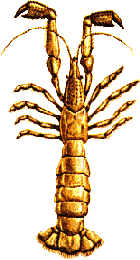 Synonyms:
Thalassina littoralis Risso, 1816; Gebia littoralis
Czerniavsky, 1884; Zernov, 1913; Upogebia litorallis
Makarov, 1938; Dolgopolskaia,1948; Upogebia pusilla
Holthuis,1961
Synonyms:
Thalassina littoralis Risso, 1816; Gebia littoralis
Czerniavsky, 1884; Zernov, 1913; Upogebia litorallis
Makarov, 1938; Dolgopolskaia,1948; Upogebia pusilla
Holthuis,1961Upogebia pusilla Petanga, 1792
 Synonyms:
Thalassina littoralis Risso, 1816; Gebia littoralis
Czerniavsky, 1884; Zernov, 1913; Upogebia litorallis
Makarov, 1938; Dolgopolskaia,1948; Upogebia pusilla
Holthuis,1961
Synonyms:
Thalassina littoralis Risso, 1816; Gebia littoralis
Czerniavsky, 1884; Zernov, 1913; Upogebia litorallis
Makarov, 1938; Dolgopolskaia,1948; Upogebia pusilla
Holthuis,1961
Common names: Engl: Flat-browed mud shrimp; Bulg: Upogebiya; Rom: Gebia; Russ: Morskoy krot; Turk: Mamun; Ukr: Mors'ky krit
Order: DECAPODA
Family: CALLIANASSIDAE
Taxonomic descriptions: The body of this Decapoda representative has soft cover because of its specific way of life: it inhabits self-dug holes in the bottom. The body is flat, consisting of cephalothorax and abdomen, with a longitudinal line on the back side - Linea thallassinica. A broad triangular rostrum covered with filaments that screen the eyes furnishes the front end of the cephalothorax. The first pair of extremities has the form of tongs, equal in size and form. The rest of the extremities have a simple structure and are covered with filaments too. The colour is very variable: brown or gray-green on the back part of the body and pale or light-yellow on its ventral part. The colour variation is due to the pigment layer in the outer part of the carapace that is rich in chromatic cells with different pigments and the animal changes its color according to the environment. The length reaches up to 45 mm.
 IUCN
Status:
IUCN
Status:
World level:
Black Sea Regional level:
Subregion level: EN
Distribution:
Habitats type, Critical habitats, Limiting factors: Upogebia pusilla inhabits most often the sandy-clay and muddy bottom, digging its holes there. Sometimes after a heavy storm it is found cast on the shore. A specific feature of Upogebia pusilla behavior is that it leaves the holes during the night to search for food. This determines its mass mortality in conditions of oxygen deficiency in the water, which is most expressed in the night in the near bottom layers and is a result of intensive summer phytoplankton blooming repeatedly occurring during the last 10 years.
Biology: This species lives in holes in the ground that it leaves only to seek food. It feeds on dead organic matter. It is monosexual, with summer reproduction. Many benthic species fish feed on it - flounder, gobbies etc.
Population trends: In the 1960 s the species had considerably high coefficient of occurrence all over the Bulgarian shelf - 18.3%. At the beginning of the 1980 s U. littoralis had the highest mean biomass of the crustaceans in Burgas bay. In Varna bay in the same period it was a common species in the biocenoses called by its name Upogebia pusila. In the 1990 s a strong reduction of the population was recorded. This resulted from the mass mortality of benthic organisms in the postblooming hypoxia periods that began from 1986. Four dead individuals per sq.m were recorded in Varna bay on 29.06.1989 and in 1991 the species did not occur in the benthic samples at all. Single individuals were registered in 1996 around Cape Kaliakra and in front of Burgas bay.
Threats: The hypoxia in the bottom water layers during the summer due to the blooming of phytoplankton.
Conservation measures taken: No conservation measures have been taken up to now.
Conservation measures proposed: Reduction of pollution and eutrophication to restrict the algae blooming that leads to hypoxia and mass mortalities of benthic organisms.
References:
Compiled by: T.Konsulova